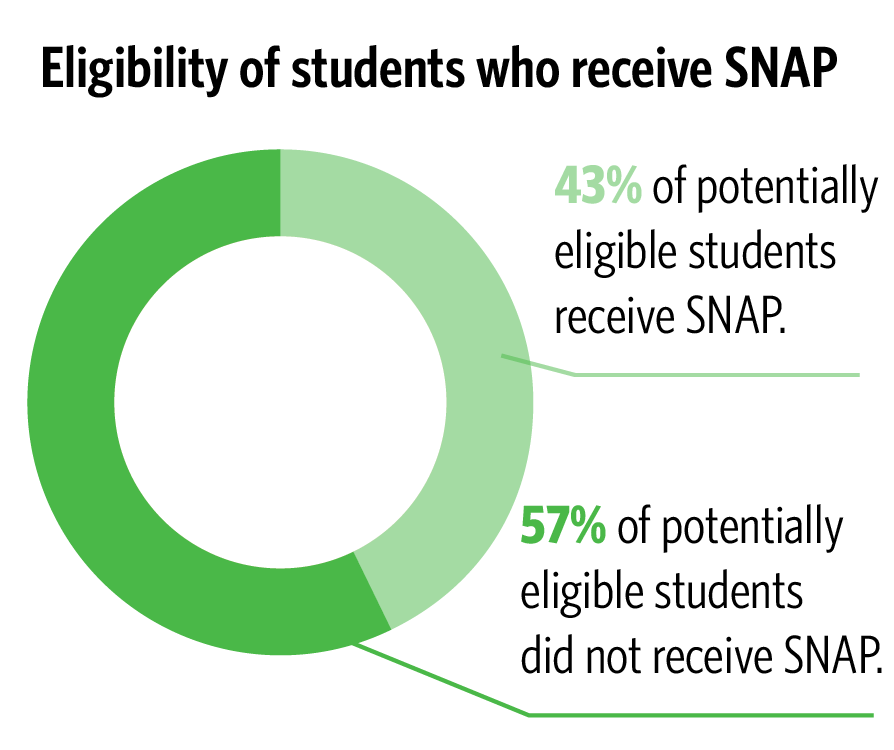Food insecurity leads to federal investigations
Source: U.S Government Accountability Office
Jan 24, 2019
For Cassandra Nikolaus, Sundays were all about food.
She used this day to prepare all of her food for the upcoming week, walking to three different grocery stores and using coupons to find the best deals in a one-mile radius.
Food insecurity leads to federal investigations
Food insecurity and homelessness a growing problem on college campuses
Her purchase usually totaled around $50, which she paid for with food stamps and any money left over after paying her rent.
Get The Daily Illini in your inbox!
This is what food insecurity looked like for Nikolaus when she was an undergraduate studying nutrition at a university in Washington. Now, Nikolaus is a Ph.D. candidate at the University, where she studies food insecurity on college campuses.
“A lot of people who are going through these issues just see themselves as another broke college student. They think their issues might not be any different from someone down the hall,” Nikolaus said.
The U.S. Department of Agriculture defines food insecurity as a “lack of consistent access to enough food for an active, healthy life.”
Food insecurity has become increasingly prominent on college campuses nationwide, prompting the government to investigate, according to a recently released study from the Government Accountability Office.
According to the report, the GAO was asked to research this issue due to the federal investment in higher education and the risk food insecurity might have on students completing their degrees.
The GAO noted there is limited information about the national prevalence of food insecurity among college students. In the analysis, the office reviewed 31 studies that identified a wide range of food insecurity rates among student subjects.
Ann Marie Morgan, assistant dean of students, said the Office of the Dean of Students has had students experiencing food insecurity come in, but they do not record how many students come in for that reason.
Morgan said all campuses across the country are seeing an uptake in students who have issues with food insecurity and homelessness. This has caused conversations on a national level about how to best serve these students.
“We know if you are struggling with housing or struggling with food, it is going to affect your academics,” Morgan said. “You are not really going to be in a place where you can be your best academic self.”
College students at risk of food insecurity may be eligible for benefits from the Supplemental Nutrition Assistance Program, a program through Food and Nutrition Services which offers nutrition assistance to low income individuals.
The GAO found that almost two million at-risk students who were potentially eligible for SNAP did not report receiving benefits in 2016.
Nikolaus said there are a variety of factors that can influence whether or not they pursue SNAP benefits. She said some students might not want to receive SNAP benefits out of pride since they want to be able to be independent and pay for food without help.
Nikolaus said some students might not even know they can use SNAP benefits.
“Not everyone knows what is available to students, mostly because there are restrictions about how you can use SNAP benefits as a student. You have to be working 20 hours a week or more,” Nikolaus said.
The notion of a poor college student subsisting on cheap ramen noodles has been around for a long time, but this image is different than true food insecurity, Morgan said.
“True food insecurity, where I don’t know where my next meal is coming from, is different and a much more recent phenomenon,” Morgan said.
The landscape of higher education looks very different from when the stigma of being a broke college student came about, Nikolaus said. Higher education used to be much less accessible.
“When the universities started opening their doors to more diverse populations, they opened their doors without realizing that the costs and the burdens of pursuing a higher education degree come with support that needs to go along with it,” Nikolaus said.
Nikolaus said food insecurity can look different depending on the college campus. She said there is evidence that suggests community college students are at a higher risk.
“That doesn’t necessarily mean that food insecurity isn’t also present on an institution like this, or even private universities, because our landscape of students has changed so dramatically from what it used to be,” Nikolaus said.
The Dean of Students Office offers a variety of resources to students who are experiencing food insecurity or financial concerns. A resource page on their website includes links to local food pantries and how to get involved with SNAP, but ultimately, students make the decision on what resources are right for them, Morgan said.






